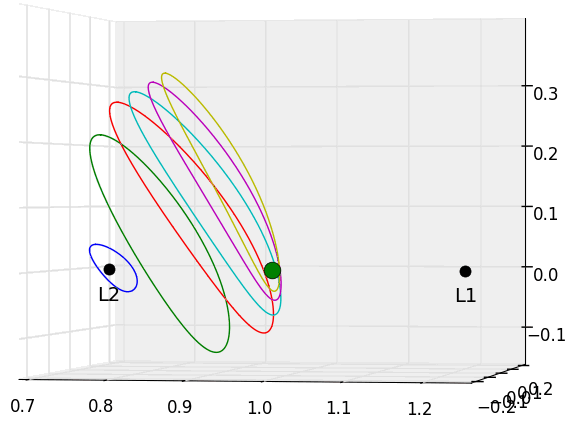I'll state my mathematical question about the state propagation and state transition matrices first, then show you a simple problem for which I would like to use these concepts to generate a densely spaced family of halo orbits.
I'll also preface with the statement that I'm looking for an Aha! type answer. I am not hoping for an explanation as long as this excellent, intuitive explanation of quaternions. I don't need everything worked out, just some explanation how one would go about understanding, getting, and using the State Transition Matrix in this context.
The following is fairly standard, I'm quoting from a paper I happen to have handy at the moment, Juan Senent, Cesar Ocampo, and Antonio Capella; Low-Thrust Variable-Specific-Impulse Transfers and Guidance to Unstable Periodic Orbits. Journal of Guidance, Control, and Dynamics, 28 (2) March–April 2005:
For the dynamical system
$$\mathbf{\dot x} = \mathbf{f}(\mathbf{x})$$
evaluated from $t_0=0$ to some $t=t_f$, the final state differential at $t_f$ is given by
$$\text{d} \mathbf{x}_f = \mathbf{\Phi}(t_f, t_0) \delta \mathbf{x}_0 + \mathbf{\dot x}_f \text{d} t_f$$
where the state transition matrix satisfies
$$\mathbf{\dot \Phi} (t,t_0) = \mathbf{F}(\mathbf{x}(t)) \mathbf{\Phi}(t, t_0) $$
and
$$\mathbf{\Phi} (t_0, t_0) = \mathbf{I}_{6 \times 6} $$
and $\mathbf{F}$ is the Jacobian of the vector field used as the state propagation matrix,
$$\mathbf{F}(\mathbf{x}(t)) = \frac{\partial\mathbf{f}(\mathbf{x})}{\partial \mathbf{x}}$$
I've started with the classic paper written by Kathleen Connor Howell Three-Dimensional, Periodic 'Halo' Orbits Celestial Mechanics 32 (1984) 53-71. It describes a technique to find solutions for halo orbits in the the Circular Restricted 3-body Problem (CR3BP), closely following a technique described by Breakwell, J. V. and Brown, J. V.: 1979, The "Halo" Family of 3-Dimensional Periodic Orbits in the Earth-Moon Restricted 3-Body Problem Celest. Mech. 20, 389.
Howell 1984 describes in detail a step-by-step procedure to find members of a family of halo orbits about the Lagrange co-linear libration points which have symmetry about the x-z plane, by taking advantage of the fact that for this group of orbits three of the six components of the state vector should converge to zero at the point where the orbit intersects the plane.
The paper tabulates six examples of halo orbits, and with the numbers given there I can integrate the state vectors, verify that the three state vector components $y, v_x, v_z$ do indeed pass through zero at the midpoint of the orbits, and make a nice plot.
What I would like to do is to understand intuitively what is a state propagation vector and a state transition vector, and how to use these to converge faster on a new member of the halo orbit family than if I had just started shooting orbits in a cluster around a starting point and used something simple like steepest descent to find the next orbit with $y, v_x, v_z$ all equal to zero.
$$\ddot{x}=x+2\dot{y}-\frac{(1-\mu)(x+\mu)}{r_1^3}-\frac{\mu(x-1+\mu)}{r_2^3}$$
$$\ddot{y}=-2\dot{x}+y\left( 1-\frac{1-\mu}{r_1^3} -\frac{\mu}{r_2^3}\right)$$
$$\ddot{z}=-z\left( \frac{1-\mu}{r_1^3} + \frac{\mu}{r_2^3} \right) $$
where
$$r_1=\sqrt{(x+\mu)^2 + y^2 + z^2}$$
$$r_2=\sqrt{(x-1+\mu)^2 + y^2 + z^2}$$
NOTE! I believe that the labels for the positions of L${}_1$ and L${}_2$ in the GIF and script are transposed (incorrect labels/names). I'll update the image soon.
def deriv(X, t):
x, y, z, xdot, ydot, zdot = X
r1 = np.sqrt((x + mu)**2 + y**2 + z**2)
r2 = np.sqrt((x - 1. + mu)**2 + y**2 + z**2)
term_1 = x + 2. * ydot
term_2 = -(1.-mu) * (x + mu) / r1**3
term_3 = -mu * (x - 1. + mu) / r2**3
xddot = term_1 + term_2 + term_3
term_1 = -2. * xdot
term_2 = 1. - (1.-mu)/r1**3 - mu/r2**3
yddot = term_1 + y * term_2
term_1 = (1. - mu)/r1**3 + mu/r2**3 # should be plus???
zddot = -z * term_1
return np.array([xdot, ydot, zdot, xddot, yddot, zddot])
class Sat(object):
def __init__(self, X0, T0, nu12):
self.X0 = X0
self.pos0 = X0[:3]
self.v0 = X0[3:]
self.T0 = T0
self.nu1, self.nu2 = nu12
import numpy as np
import matplotlib.pyplot as plt
from scipy.integrate import odeint as ODEint
from mpl_toolkits.mplot3d import Axes3D
# From "Three-Dimensional, Periodic 'Halo' Orbits,
# Kathleen Connor Howell, Celestial Mechanics 32 (1984) 53-71
pi, twopi = np.pi, 2*np.pi
mu = 0.04
# starting points:
x0 = [0.723268, 0.729988, 0.753700, 0.777413, 0.801125, 0.817724]
y0 = 6*[0.0]
z0 = [0.040000, 0.215589, 0.267595, 0.284268, 0.299382, 0.313788]
xdot0 = 6*[0.0]
ydot0 = [0.198019, 0.397259, 0.399909, 0.361870, 0.312474, 0.271306]
zdot0 = 6*[0.0]
# X0s = np.array(zip(x0, y0, z0, xdot0, ydot0, zdot0)) Nope!
X0s = np.array(list(zip(x0, y0, z0, xdot0, ydot0, zdot0)))
Thalf0s = [1.300177, 1.348532, 1.211253, 1.101099, 1.017241, 0.978653]
T0s = [2.0*x for x in Thalf0s]
nu1s = [1181.69, 51.07839, 4.95816, 1.101843, 0.94834, 1.10361]
nu2s = [ 0.98095, -0.90203, -0.40587, -0.420200, -1.58429, -2.09182]
nu12s = zip(nu1s, nu2s)
n_half = 200
fractional_times = np.linspace(0.0, 1.0, 2*n_half+1)
rtol, atol = 1E-12, 1E-12
sats = []
for X0, T0, nu12 in zip(X0s, T0s, nu12s):
sat = Sat(X0, T0, nu12)
sat.n_half = n_half
sat.t = sat.T0 * fractional_times
sat.rtol, sat.atol = rtol, atol
sats.append(sat)
for sat in sats:
answer, info = ODEint(deriv, sat.X0, sat.t,
rtol=sat.rtol, atol=sat.atol,
full_output = True )
sat.answer = answer
sat.mid = answer[sat.n_half]
sat.mid = answer[sat.n_half]
sat.info = info
if 1 == 1:
xL2, xL1 = 0.74091, 1.21643 # lazy!
fig = plt.figure(figsize=[10, 8])
ax = fig.add_subplot(1, 1, 1, projection='3d')
for sat in sats:
x, y, z = sat.answer.T[:3]
ax.plot(x, y, z)
ax.plot([0.0-mu], [0], [0], 'ob', markersize=20)
ax.plot([1.0-mu], [0], [0], 'og', markersize=12)
ax.plot([xL2], [0], [0], 'ok', markersize=8)
ax.plot([xL1], [0], [0], 'ok', markersize=8)
ax.set_xlim(0.7, 1.25)
ax.set_ylim(-0.225, 0.225)
ax.set_zlim(-0.15, 0.40)
ax.text(xL1, 0, -0.05, "L1", fontsize=14, horizontalalignment='center')
ax.text(xL2, 0, -0.05, "L2", fontsize=14, horizontalalignment='center')
nplot = 80
thetas = np.linspace(0, twopi, nplot+1)[:-1]
azimuths = -90 + 10.0 * np.cos(thetas)
fnames = []
for i, azim in enumerate(azimuths):
fname = "haloz_3D_" + str(10000+i)[1:]
ax.elev, ax.azim = 0, azim
plt.savefig(fname)
fnames.append(fname)
# tight cropping
for i in range(len(fnames)):
fname_in = "haloz_3D_" + str(10000+i)[1:]
fname_out = "haloz_3D_crop_" + str(10000+i)[1:] + ".png"
img = plt.imread(fname_in + ".png")
plt.imsave(fname_out, img[200:-175, 240:-190])





